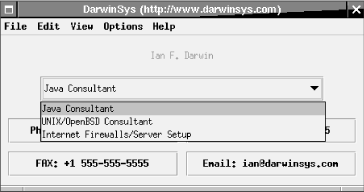Program: BusCard
This program may seem a bit silly, but it’s a good example of
configuring a variety of user interface controls from a
resource bundle. The
BusCard program allows you to create a digital
business card (“interactive business card”) on-screen
(see Figure 14-2). The labels for all the GUI
controls, event the pull-down menu, are loaded from a
ResourceBundle.

Figure 14-2. BusCard program in action
Example 14-2 shows the code for the
BusCard
program.
Example 14-2. BusCard.java
import java.awt.*; import java.awt.event.*; import java.util.*; import javax.swing.*; /** Display your business-card information in a Java window. * * This is a first attempt. The next version should use a GridBagLayout. */ public class BusCard extends JFrame { JLabel nameTF; JComboBox jobChoice; JButton B1, B2, B3, B4; /** "main program" method - construct and show */ public static void main(String[] av) { // create a BusCard object, tell it to show up new BusCard( ).setVisible(true); } /** Construct the object including its GUI */ public BusCard( ) { super( ); Container cp = getContentPane( ); cp.setLayout(new GridLayout(0, 1)); addWindowListener(new WindowAdapter( ) { public void windowClosing(WindowEvent e) { setVisible(false); dispose( ); System.exit(0); } }); JMenuBar mb = new JMenuBar( ); setJMenuBar(mb); ResourceBundle b = ResourceBundle.getBundle("BusCard"); JMenu aMenu; aMenu = I18N.mkMenu(b, ...Get Java Cookbook now with the O’Reilly learning platform.
O’Reilly members experience books, live events, courses curated by job role, and more from O’Reilly and nearly 200 top publishers.

